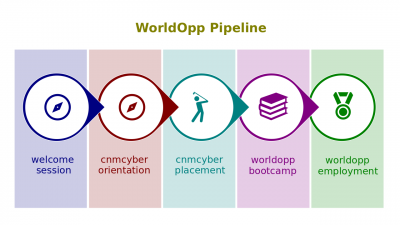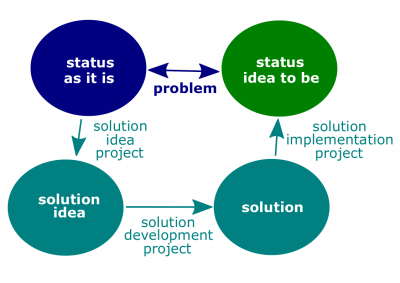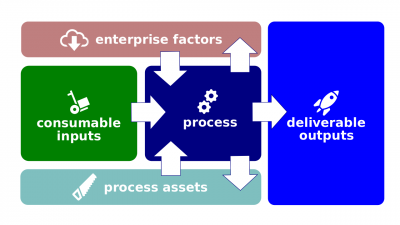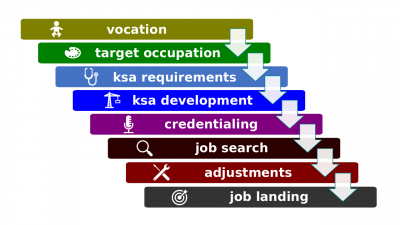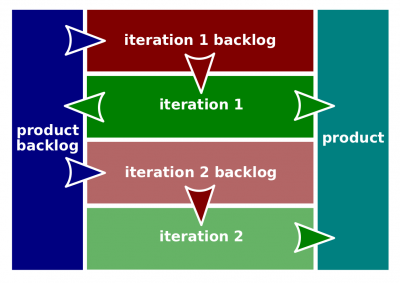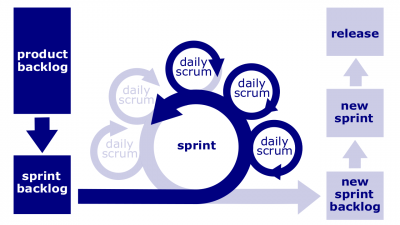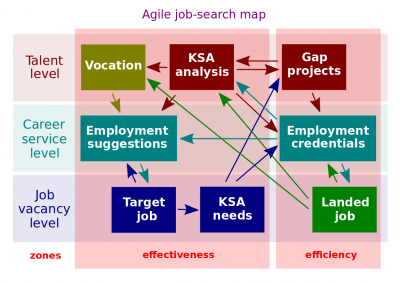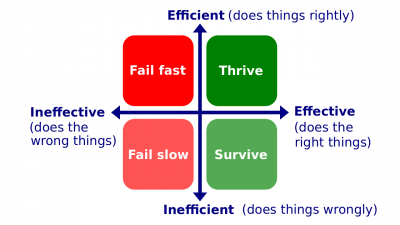Difference between revisions of "Career Endeavors"
(→Project administration) |
(→Agile model for a career) |
||
| Line 39: | Line 39: | ||
:[[File:Iteration-backlog.png|400px|thumb|right|[[Iterative development]]]][[File:Scrum.png|400px|thumb|right|[[Sprint]]]][[Agile methodology|Agile]] is another [[methodology]] of administering [[project]]s. An [[Agile project]] is usually completed in several [[iteration]]s. In different models these development cycles can also be called [[sprint]]s and scrums. The results of each iteration shall be used to setup objectives for other iterations. So, instead of one huge and costly project without clear understanding of its outcome, the [[Agile methodology]] offers many smaller trials and, sometimes, fails in order to clarify objectives while on the way. | :[[File:Iteration-backlog.png|400px|thumb|right|[[Iterative development]]]][[File:Scrum.png|400px|thumb|right|[[Sprint]]]][[Agile methodology|Agile]] is another [[methodology]] of administering [[project]]s. An [[Agile project]] is usually completed in several [[iteration]]s. In different models these development cycles can also be called [[sprint]]s and scrums. The results of each iteration shall be used to setup objectives for other iterations. So, instead of one huge and costly project without clear understanding of its outcome, the [[Agile methodology]] offers many smaller trials and, sometimes, fails in order to clarify objectives while on the way. | ||
| − | ===Agile | + | ===Agile career project=== |
:[[File:Career-administration.png|400px|thumb|[[Agile career-administration model]]]]The goal of the [[Agile career-administration model]] is to navigate [[employment candidate]]s. We can see the talent level is on the top, the career service one in the middle, and the job vacancy level is on the bottom. | :[[File:Career-administration.png|400px|thumb|[[Agile career-administration model]]]]The goal of the [[Agile career-administration model]] is to navigate [[employment candidate]]s. We can see the talent level is on the top, the career service one in the middle, and the job vacancy level is on the bottom. | ||
Revision as of 00:28, 29 January 2019
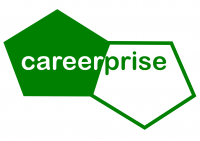
Careerprise's trade mark
Career Projects is the second presentation in the Introduction to Careers lecture. The lecture itself is the fourth in WorldOpp Orientation. Consequently, the Orientation is the first stage of WorldOpp Pipeline.
This wikipage presents its full script and those test questions that are related to that presentation.
Contents
Script
The video of the presentation is published at https://youtu.be/Lqz0dcn9CRo (6:14). Here is its full text.
Overview
- Welcome to Career Projects. In this brief presentation, we are going to define projects and take a look at those tools that employment candidates can use in order to land their promising jobs. Let's go.
What a project is
- Project is a one or more endeavors undertaken in order to create a unique deliverable. When employment is a desired deliverable, we can surely state that one is in a project to land one's job. Landing a job can be called a career project.
- Let's take a look at the available illustration. There are two statuses -- one on the upper left is as it is and another on the upper right is to be. The difference between these two is called a problem to be solved. There should be some solution, but usually that solution needs to be yet identified.
- Every project is nesting. Solving a problem is a project, but creating a solution or even development of an idea for the solution are projects too. To indicate that they are parts of a bigger projects, they can be called subprojects.
What a process is
- If we get back to our definition of a project, it suggests that any project can be viewed as a set of processes.
- A process is a sequence of activities undertaken in order to achieve particular results. Systems engineers may also define a process as converting inputs into outputs using some tools and techniques while being influenced by enterprise factors.
- Does it sound complicated? If you collected all available information and need to create an idea of a solution, your time would be an input, information would be your tool, decision-making methods would be your techniques, legal and ethical considerations can be your factors, and an idea would be your output.
Project administration
- Administering projects particularly includes sequencing processes, project phases, and subprojects that are required in order to accomplish a project. There are several approaches and, in this presentation, we will consider two.
Job search as a waterfall
- A traditional model is called the career waterfall. Many career counselors may recommend this route.
- Waterfall refers to a sequential process where progress is seen as flowing steadily downwards through the phases. These phases may vary, but often consist of, a, discovering one's vocation, bee, suggesting one's target occupation, see, identifying work-related competence needed for a particular position, dee, development of one's KSAs, ee, development one's employment credentials, eff, job search, gee, adjustments to the job market, and, aitch, landing one's job in the target occupation.
- Let's add some real life example; just the name is changed to preserve the privacy. Meet Lisa, who used to believe that management was her vocation. Her parents believed in that too. She attended a college for 4 years to earn an academic credential in operations management with concentration in managerial accounting, but no one wanted to hire her because of her lack of work experience. She started working as a sales representative and eventually stays in that occupation till now. She doesn't regret about her 4 years in a college, and says that it was fun, but she has never managed any operations using managerial accounting in her career.
- That example is not everyone's case, but there is no way that everything in that many-years project would go as planned and a great chunk of time -- and often money -- wouldn't be wasted.
Agile job search
- Agile is another methodology of administering projects. An Agile project is usually completed in several iterations. In different models these development cycles can also be called sprints and scrums. The results of each iteration shall be used to setup objectives for other iterations. So, instead of one huge and costly project without clear understanding of its outcome, the Agile methodology offers many smaller trials and, sometimes, fails in order to clarify objectives while on the way.
Agile career project
- The goal of the Agile career-administration model is to navigate employment candidates. We can see the talent level is on the top, the career service one in the middle, and the job vacancy level is on the bottom.
- Let's go over this model using Lisa's example. She had some vocation and thought that she would be paid well and would do that for a long time. Not to start from scratch, she also had some knowledge, skills, and abilities known as KSAs. There is no single path. However, if she knew like 50% of basic bookkeeping from her first semester in her college, she could have started looking for a job of an entry-level bookkeeper in the tax season. Even if she worked as a volunteer, she would test whether bookkeeping fits his vocation. If she liked it, she could switch her major to accounting or anything else. In 4 years, Lisa would have a 4-year degree, 3 years of experience and an actual job.
- Employment suggestions is the place which can match you to your target job. These target jobs have some requirements, which can be expressed as KSAs.
- A particular bookkeeping job pretty much always has its requirements -- its defines what their bookkeeper needs to known, what be skilled at, and what be able to do. Let say, Educaship Alliance LLC hires someone who needs to know debits and credits, as well to be able to do income statements and balance sheets. These KSAs should be compared with those KSAs which Lisa already has and the gaps can be found. Let's assume that Lisa knows and is able everything that the employer looks for, besides income statements. To fill in this void is his gap project. Lisa can start to concentrate on income statements in order to add it to his "toolbox."
- Usually someone needs to credential you in order to get a job, and any recruiter will look for your credentials. You cannot say you know everything in a particular field, someone needs to prove it. Sometimes some employment credentials include academic degrees, some are not. When employment credentials are setup, it can lead to a job interview, which can be considered as a credential too.
- Back to the example, Educaship Alliance LLC may give Lisa some work sample test -- let say, accomplish an income statement. If Lisa does so, she may land the job. Then, he will put his hands on and have a feeling whether he wants to continue or do something that in Agile methodology is called "pivot."
- The most important feature of the Agile career-administration model is that a big project is chunked in many smaller ones and results in one can define objectives for another.
Effectiveness versus efficiency
- Let's get back to the Agile model. We can see that the endeavors on the left lay in the effectiveness zone, while the one on the right do in the efficiency zone. With regard to careers, effectiveness refers to targeting right jobs and efficiency refers to landing jobs faster. The left side of this illustration is about choosing the direction to go and the right side is about actually going.
- Now, let's go to another illustration. This matrix displays what may happen if you go fast in a wrong direction. You are just investing your time and effort into your career "death."
- At the same time, most of professional workforce service providers concentrate on efficiency -- résumés, interviewing skills, and so on. Of course, it is helpful to those job seekers who know their direction. There is a chance that the others play a Russian roulette, which is a lethal game of chance -- the options are to stay alive or die.
Summary
- This concludes the Career Projects presentation. We have defined projects and taken a look at the career waterfall. We have also used the Agile career-administration model to go over endeavors that employment candidates may undertake in order to land their jobs. The special stress was made on the difference between efficiency and effectiveness in career administration. If you haven't done yet so, you are now welcome to move to Employment Credentials.
Quiz questions
- Every statement below is split into one true and one false question in the actual exam.
See also
- Employment Credentials. The third presentation in Introduction to Careers.
- Career Essentials. The first presentation in Introduction to Careers.
